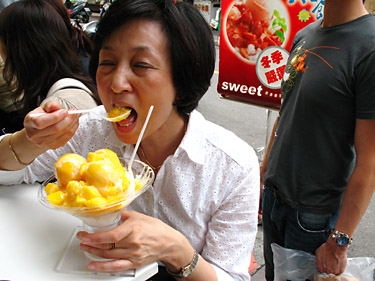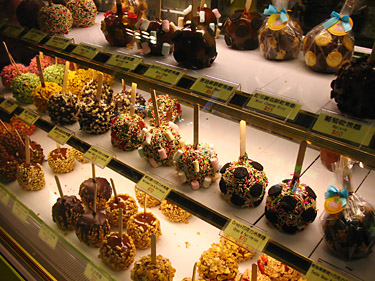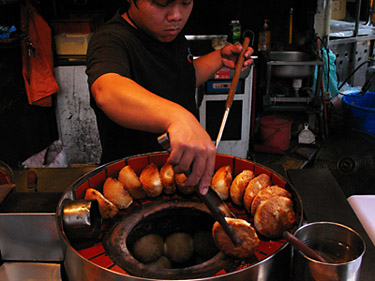Street snacks
There are far too many street stalls and portable snacks in Taipei to list, many located outside the sprawling night markets. Here is a sampling of some of the more unusual.

Eggs of all kinds
My people love eggs! Useful for so many things. Eggs are far from just breakfast food in Chinese cooking; scrambled eggs with scallions or tomatoes is a common dinner dish, egg drops appear in a variety of soups from minced beef to hot and sour, and thousand-year-old eggs are one of the cuisine's most famous oddities.
Most unusual food preparation methods stem from necessity. These are no exception: Chinese people needed a way to increase the shelf life of eggs in the days before refrigeration, and came up with a few ingenious ideas.
Tea eggs. These are simply hard-boiled eggs simmered in black tea for an hour or so. The shells are cracked lightly before immersing in tea, resulting in a beautiful marbled effect on the whites. Easy and common to make at home.
Iron eggs. These are a Taiwanese specialty, made by repeating cycles of boiling in soy sauce and drying until the whites turn black and achieve a leathery texture. They aren't as hard as the name implies, however, more a pleasant "al dente" feel with a fantastic infused flavor. These are an absolute must-try off the streets of Taipei.
Thousand-year-old eggs.These are generally made from duck eggs, but I believe quail eggs can also be used. Eggs are coated in a clay-like mixture of tea, ashes and salt, buried and cured for 100 days. (That beats refrigeration records!) The whites turn gelatinous and the yolks turn green...they doesn't look appetizing but really are quite tasty. They are available off the street for snacking but are best sliced into congee.

Ice Monster
Every Asian island nation must eventually arrive at the idea of creating a dessert from shaved ice. I'll include Hawaii in this assessment. Tropical heat and a people that tends toward lactose intolerance makes shaved ice preferable to ice cream. My parents had dreamed of chi bing (eating ice) since arrival.
In Taiwan, the most traditional combination is ice with sweet red beans and condensed milk. Other options are taro (a root vegetable that is often sweetened for Chinese pastries) or fruit. The new chain Ice Monster expands on these options by adding ice cream for those young folks that grew up on dairy. As expected, my dad beelined for the red-bean variety, while my mom scarfed down a dish covered in mango cubes and mango ice cream. Portions are extremely generous, and very refreshing. Traditional combo is the cheapest at 60NT (less than $2), but all prices are very reasonable.
Ice Monster recently opened a branch in Tokyo to enormous success, which may account for the large number of Japanese tourists we saw at the Yongkang street outpost.

Candy Apples
Ximending is the young and trendy shopping district, with its own cutesy mascot (an alien-like creature with the "xi men"—west gate—on its head), and a cutesy snack to match! I'm not really sure these candy apples originated in this area but I saw 2 candy-apple shops there and no where else. These unique candy apples are covered in all sorts of random sweets, like gummy bears, marshmallows or mini-Oreos. I even saw mini-Ritz's, which didn't sound like a great combination. We split a "turtle" apple, which was chocolate and caramel dipped in peanuts...absolutely scrumptious. At only a couple dollars, I kind of wished I had room to try another.

Pepper buns
These delicious mounds are something I've definitely never seen in the States. Hu-jiao bing originated in Fuzhou province, from where many Taiwan citizens emigrated. The buns are baked inside a furnace-like drum, where the soft dough sticks to the side and forms a crust. The crispy shells encase savory ground pork & green onions with lots of black pepper. Great flavor—not too spicy—and of course, cheap! The best place to try them is "Fujian Traditional Cuisine-Pepper Cookie" on Yongkang Street, conveniently located across from Ice Monster.